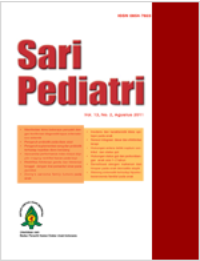Prevalensi dan Faktor Risiko Catheter Associated Urinary Tract Infection di Unit Perawatan Intensif Anak
Sari
Latar belakang. Sekitar 80% Infeksi Saluran Kemih yang didapat di rumah sakit yang berhubungan dengan penggunaan kateter urin atau catheter-associated urinary tract infection. Beberapa faktor risiko dianggap memengaruhi kejadian CAUTI. Hingga saat ini, prevalensi CAUTI pasien anak di Rumah Sakit Dr. Hasan Sadikin belum tercatat dan pola kuman penyebab CAUTI serta sensitivitas antibiotik dapat bervariasi antar rumah sakit.
Tujuan. Mengetahui prevalensi catheter-associated urinary tract infection di Unit Perawatan Intensif Anak Rumah Sakit Hasan Sadikin dan menganalisis faktor risiko yang menyebabkannya.
Metode. Penelitian ini merupakan studi observasional analitik dengan metode kasus-kontrol menggunakan data sekunder dari rekam medis pasien yang terpasang kateter urin, dirawat di Unit Perawatan Intensif Anak Rumah Sakit Umum Pusat Dr. Hasan Sadikin tahun 2017-2019, baik terdiagnosis CAUTI maupun tidak terdiagnosis CAUTI.
Hasil. Sebanyak 138 subjek memenuhi kriteria inklusi penelitian, kemudian dikelompokkan masing-masing 69 pasien kriteria kasus dan kontrol. Sebagian besar subjek berjenis kelamin laki-laki. Usia terbanyak adalah 11-18 tahun (33,3%) pada kelompok kasus dengan status gizi normal (50,7%). Dari enam faktor risiko yang diteliti hanya satu yang menunjukkan perbedaan bermakna yaitu diagnosis awal saat dirawat (sepsis).
Kesimpulan. Prevalensi CAUTI cukup tinggi. terutama terkait dengan diagnosis awal sepsis. Penelitian lanjutan perlu dilakukan dan pemeriksaan rutin kultur urin dianjurkan untuk diagnosis dan terapi yang efektif.
Kata Kunci
Teks Lengkap:
PDFReferensi
Flores-Mireles AL, Walker JN, Caparon M, Hultgren SJ. Urinary tract infections: epidemiology, mechanisms of infection and treatment options. Nature Rev Microbiol 2015;13:269-84.
Pardede SO. Infeksi pada ginjal dan saluran kemih anak: manifestasi klinis dan tata laksana. Sari Pediatri 2018;19:364-74.
Shaikh N, Hoberman A, Keren R, Gotman N, Docimo SG, Mathews R, dkk. Recurrent urinary tract infections in children with bladder and bowel dysfunction. Pediatrics 2016;137:1-7
Flores-González J, Hernández-González A, Rodríguez-López C, Roldán-Cano V, Rubio-Quiñones F, Quintero-Otero S, dkk. Nosocomial urinary tract infection in critical pediatric patients. Medicina Intensiva (English Edition) 2011;35:344-8.
Düzkaya DS, Bozkurt G, Uysal G, Yakut T. The effects of bundles on catheter-associated urinary tract infections in the pediatric intensive care unit. Clin Nurs Specialist 2016;30:341-6.
Prashamsa K, Devi D, Madhup S, Shrechand J. Catheter associated urinary tract infection: prevalence, microbiological profile and antibiogram at a tertiary care hospital. Acclm; 2017.
Maharjan G, Khadka P, Siddhi Shilpakar G, Chapagain G, Dhungana GR. Catheter-associated urinary tract infection and obstinate biofilm producers. Can J Infect Dis Med Microbiol 2018;2018.
Rinke ML, Oyeku SO, Heo M, Saiman L, Zachariah P, Rosenberg RE, dkk. Pediatric ambulatory catheter-associated urinary tract infections (CAUTIs): Incidence, risk factors, and patient outcomes. Infect Control & Hospital Epidemiol 2020:1-9.
Weber DJ, Sickbert-Bennett EE, Gould CV, Brown VM, Huslage K, Rutala WA. Incidence of catheter-associated and non-catheter-associated urinary tract infections in a healthcare system. Infect Control & Hospital Epidemiol 2011;32:822-3.
Ismail A, El-Hage-Sleiman A-K, Majdalani M, Hanna-Wakim R, Kanj S, Sharara-Chami R. Device-associated infections in the pediatric intensive care unit at the American University of Beirut Medical Center. J Infect Develop Countries 2016;10:554-62.
Saint S, Greene MT, Kowalski CP, Watson SR, Hofer TP, Krein SL. Preventing catheter-associated urinary tract infection in the United States: a national comparative study. JAMA Internal Medicine. 2013;173:874-9.
Devrim F, Serdaro?lu E, Ça?lar ?, Oruç Y, Demiray N, Bayram N, dkk. The emerging resistance in nosocomial urinary tract infections: from the pediatrics perspective. Mediterranean J Hematol Infect Dis 2018;10:1-5
Letica-Kriegel AS, Salmasian H, Vawdrey DK, Youngerman BE, Green RA, Furuya EY, dkk. Identifying the risk factors for catheter-associated urinary tract infections: a large cross-sectional study of six hospitals. BMJ open 2019;9:e022137.
Lee NG, Marchalik D, Lipsky A, Rushton HG, Pohl HG, Song X. Risk factors for catheter associated urinary tract infections in a pediatric institution. J Urol 2016;195:1306-11.
Kauffman JD, Danielson PD, Chandler NM. Risk factors and associated morbidity of urinary tract infections in pediatric surgical patients: A NSQIP pediatric analysis. J Pediatr Surg 2019;54:1-6
Us Centers for Disease Control and Prevention. Urinary tract infections catheter-associated urinary tract infection (CAUTI) and non-catheter-associated urinary tract infection (UTI) events. National Healthcare Safety Network 2023;1-18
Tambyah PA, Oon J. Catheter-associated urinary tract infection. Current opinion in infectious diseases 2012;25:365-70.
Sugianli AK, Ginting F, Kusumawati RL, Pranggono EH, Pasaribu AP, Gronthoud F, dkk. Antimicrobial resistance in uropathogens and appropriateness of empirical treatment: a population-based surveillance study in Indonesia. J Antimicrob Chem 2017;72:1469-77.
Barford J, Coates A. The pathogenesis of catheter-associated urinary tract infection. J InfectPrevent 2009;10:50-6.
Bitsori M, Maraki S, Koukouraki S, Galanakis E. Pseudomonas aeruginosa urinary tract infection in children: risk factors and outcomes. J Urol 2012;187:260-4.
Lake JG, Weiner LM, Milstone AM, Saiman L, Magill SS, See I. Pathogen distribution and antimicrobial resistance among pediatric healthcare-associated infections reported to the National Healthcare Safety Network, 2011–2014. Infect Control and Hospital Epidemiol 2018;39:1.
DOI: http://dx.doi.org/10.14238/sp25.4.2023.249-56
Refbacks
- Saat ini tidak ada refbacks.
##submission.copyrightStatement##
##submission.license.cc.by-nc-sa4.footer##
Email: editorial [at] saripediatri.org


Sari Pediatri diterbitkan oleh Badan Penerbit Ikatan Dokter Anak Indonesia
Ciptaan disebarluaskan di bawah Lisensi Creative Commons Atribusi-NonKomersial-BerbagiSerupa 4.0 Internasional.




